Air Pollution
By Irina Bright.
This article is part of our Environment section
See the complete list of all our Pollution Articles here.
As the human population grows and the quantity of energy and materials used by each person increases, it is becoming apparent that the resource whose sufficiency is most in doubt is neither space, nor energy, nor metallic ores, but rather the capacity of natural processes to maintain a hospitable environment. (Ref. 1)
Contents
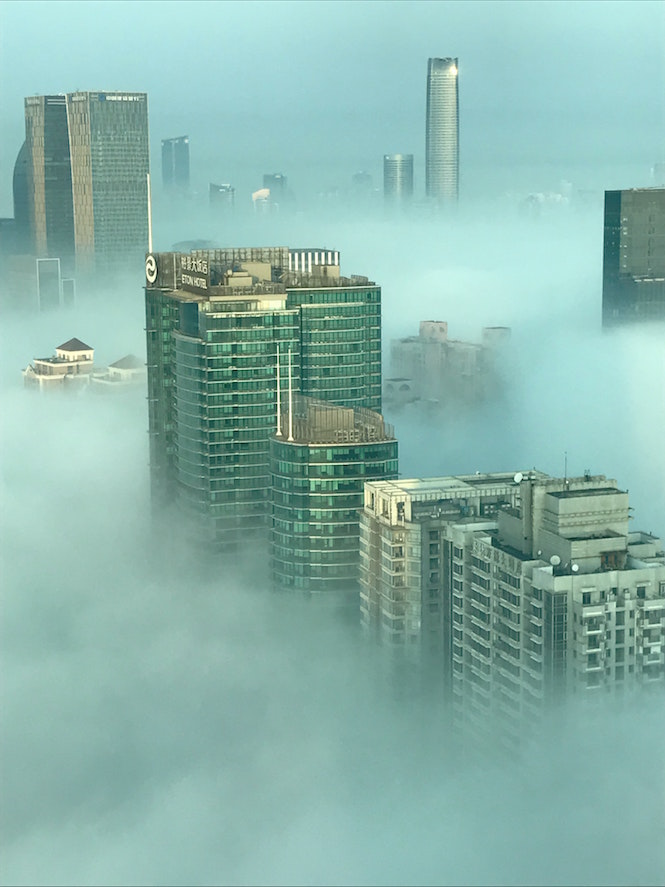 Air Pollution in a Big City.
Air Pollution in a Big City.Photo: Mikel Letona
1. Introduction
2. Causes
Fundamental CausesIndustries
Atmospheric Pollutants
Sulfur Dioxide
Nitrogen Oxides
Carbon Monoxide
Ammonia
Ozone
Other Atmospheric Pollutants
3. Effects
Effects on HumansSulfur Dioxide
Nitrogen Dioxide
Carbon Monoxide
Ozone
Ammonia
Volatile Organic Compounds
Airborne Particles
Effects on Animals
Effects on Trees
Economic Losses
4. Global Warming & Pollution
References
___Introduction
Pollution had been known to exist for centuries, but it became an issue of serious concern only in the last 200 years or so, mostly due to the industrial revolution.
Atmospheric pollution originates from all the parts of the world and travels around knowing no borders.
This transboundary nature of air pollution makes it ever more dangerous and difficult to control.
The Artic Haze is perhaps one of the best examples of that.
We are talking about a visible reddish brown haze which appears above the Arctic during winter months. The Artic Haze is caused by air pollution from coal-burning which arrives mainly from Asia. (Ref. 2)
Another interesting example is lead found in Greenland which traveled there from different parts of the planet. (Ref. 3)
Air Pollution Causes
There are natural and anthropogenic (human-made) causes of air pollution.
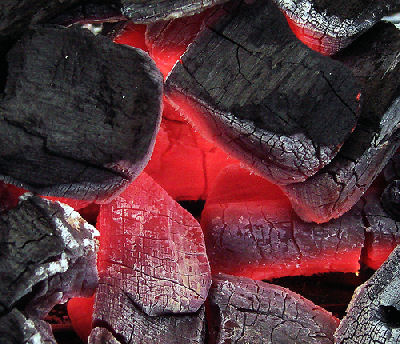 Fossil Fuels: Coal
Fossil Fuels: Coal © Marcus Vegas
Natural causes of pollution may include forest fires and volcano eruptions as well as vegetation, oceans and decay processes in soil.
It is however the anthropogenic causes that we are mostly interested in, as they no doubt play the most important role in polluting the Earth’s atmosphere.
Fossil fuels (oil, gas & coal) are the largest anthropogenic sources of air pollution – they are widely used in industry and everyday life.
But they are not the only ones.
For example, industrial processes involving some chemical reactions may also release significant amounts of pollution into the air.
We discuss anthropogenic air pollution causes in more detail below.
Fundamental Causes of Air Pollution
The fundamental causes of air pollution include such global trends as industrialization, globalization & population growth. We refer to them as the very roots of the huge pollution tree.
You can learn more about these fundamental pollution causes here.
Industries as Sources of Air Pollution
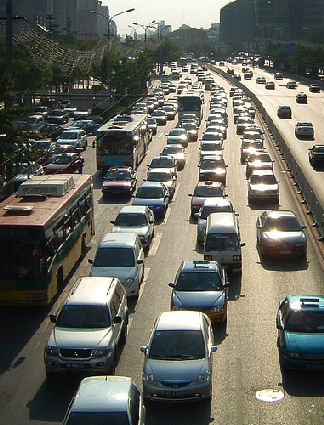 Beijing Traffic
Beijing Traffic © Aapo Haapanen
Some of the major air polluting industries are:
- Biofuel Combustion
- Manufacturing Industry & Refineries
- Power Generation
- Residential & Commercial Sector
- Road, Rail & Air Transport
Air Pollutants
There are many dangerous air pollutants emitted by virtually every industry.
Sulfur Dioxide (SO2)
Sulfur dioxide (SO2) is corrosive to organic materials and it irritates the eyes, nose and lungs; therefore it is quite a dangerous air pollutant.
Sulfur is contained within all fossil fuels, and is released in the form of sulfur dioxide during fossil fuel combustion.
The main sectors producing sulfur dioxide are:
Power Generation
Power generation is the largest industry for global SO2 emissions, which is mainly due to this industry’s use of vast amounts of fossil fuels, especially coal.
Industry
Just like power generation, manufacturing industry generates its own SO2 emissions through its use of fossil fuels.
Non-ferrous metals
Production of non-ferrous metals (ex. aluminium, copper, lead) generates SO2 emissions both through the use of fossil fuels and specificity of the industrial process involved. Learn more about it here.
Other Industries
Refineries and residential & commercial sector are another significant sources of sulfur dioxide emissions.
Nitrogen Oxides (NOx)
There are two main nitrogen oxides together referred to as NOx: nitric oxide (NO) and nitrogen dioxide (NO2).
While fossil fuel combustion produces both NO2 and NO, almost 90% of the total NOx combustion product is released in the form of NO which is then converted to NO2 in the air. (Ref. 4, 5)
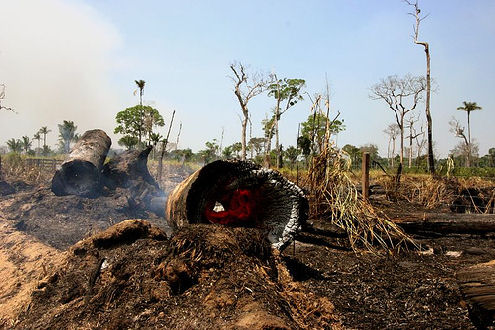 Deforestation:
Deforestation: Amazon Rainforest on Fire
© Leonardo F. Freitas
The main sectors producing nitrogen dioxide (NO2) are:
- Road Transport
- Power Generation
- Deforestation & Savannah Fires
- Industry (excl. refineries)
- Shipping
Carbon Monoxide (CO)
Carbon monoxide, a highly toxic gas, is a by-product of incomplete fossil fuel combustion.
The top sectors producing carbon monoxide are:
- Deforestation & Other Wildfires
- Biofuel Combustion
- Road Transport
- Residential & Commercial Sector
- Agriculture Waste Burning
Ammonia (NH3)
Ammonia is a pungent, hazardous caustic gas.
Agriculture, specifically livestock farming & animals waste, is the main source of ammonia emissions.
Ozone (O3)
Ozone (O3) is a poisonous gas which can be found in:
 Smog, Mexico City
Smog, Mexico City © Alfredo Cottin
- the stratosphere (upper layer of the atmosphere) where it occurs naturally and protects the Earth from harmful ultraviolet sunlight, and
- the troposphere (lowest layer of the atmosphere) where it occurs both naturally and as a product of anthropogenic emissions.
Human-induced tropospheric ozone is a secondary pollutant produced by the reaction of primary pollutants – nitrogen oxides and hydrocarbons – In the presence of sunlight.
It is one of the main components of the photochemical smog which is damaging to human and animal health.
Other Air Pollutants
Other air pollutants include volatile organic compounds (VOCs), persistent organic pollutants (POPs) and airborne particles.
VOCs are organic compounds which easily evaporate and enter the atmosphere. They may affect human and animal health directly, or indirectly as contributors to the formation of tropospheric ozone.
POPs are compounds which are resistant to degradation and persistent in the environment. They may affect human and animal health through diet, environmental exposure or accidents.
Airborne particles are very small fragments of solid or liquid nature suspended in the air. Human and animal health may be affected by particles through inhalation.
We discuss air pollution causes in more detail here.
Air Pollution Effects
Of course, atmospheric pollution would not be such a big problem if it weren’t for its harmful effects on humans, animals, trees and the wider environment.
We can distinguish between short-term acute effects and long-term chronic effects of air pollution.
Air pollutants enter the body primarily through the respiratory system which thus becomes their main victim.
Each air pollutant exerts their own specific adverse impacts, ranging from mild to really damaging.
We discuss this below.
Air Pollution Effects on Humans
Sulfur Dioxide Effects
 Asthma Sufferer, Cambodia
Asthma Sufferer, Cambodia© Masaru Goto / World Bank
Some effects of sulfur dioxide on human health include (Ref. 6, 7, 8):
- Irritation of eyes, nose, throat; damage to lungs when inhaled
- Acute and chronic asthma
- Bronchitis and emphysema (as a result of synergy between SO2 and airborne particles)
- Lung cancer
Sulfur dioxide may often act in synergy with other pollutants (ex., airborne particles) to produce certain air pollution effects.
Nitrogen Dioxide Effects
Depending on its different concentrations in the air, effects of nitrogen dioxide on human health include (Ref. 9, 10):
- Increased incidence of respiratory illness
- Increased airway resistance (due to inflammation)
- Damage to lung tissue
- Chronic obstructive pulmonary disease, or COPD (narrowing of the airways)
- Emphysema (as part of COPD)
- Pulmonary edema (accumulation of excessive fluid in the lungs)
- Infant and cardiovascular death
Exposure to high concentrations of nitrogen dioxide can make living organisms more susceptible to bacterial infections and lung cancer. (Ref. 11)
Nitrogen dioxide affects people with existing medical conditions more severely than healthy people. Children are affected easier than adults.
It is also a major component of the photochemical smog which brings its own negative effects on.
Carbon Monoxide Effects
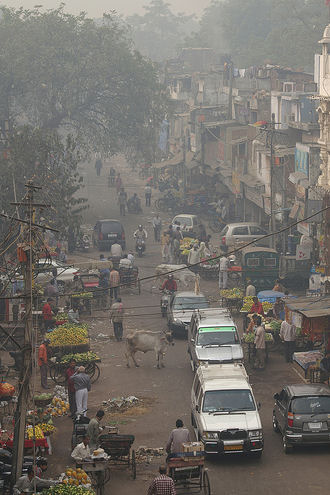
Extreme Pollution, Delhi
© Dave Morris
Exposure to carbon monoxide may lead to (Ref. 12, 13, 14):
- Toxicity of the central nervous system and heart
- Headaches, dizziness, nausea and unconsciousness
- Loss of vision
- Decreased muscular coordination
- Abdominal pain
- Severe effects on the baby of a pregnant woman
- Impaired performance on simple psychological tests and arithmetic; loss of judgment of time
- In cases of prolonged exposure to high CO concentrations, unconsciousness, convulsions and death would occur
Carbon monoxide is the most common type of fatal poisoning in many countries around the world. (Ref. 15)
Again, effects of carbon monoxide are exacerbated in people with pre-existing conditions.
Ozone Effects
Exposure to the tropospheric ozone may cause (Ref. 16, 17, 18):
- Burning nose and watering eyes
- Tightening of the chest
- Coughing, wheezing and throat irritation
- Rapid, shallow, painful breathing
- Susceptibility to respiratory infections
- Inflammation and damage to the lining of the lungs
- Aggravation of asthma
- Fatigue
- Cancer
Children are more susceptible to the negative effects of ozone than adults.
Ammonia Effects
Effects of ammonia inhalation are (Ref. 19, 20, 21):
On the respiratory system :
- Nose & throat irritation and burns (their severity increasing with the increased ammonia concentrations)
- Swelling of the throat and airways; airways destruction
- Pulmonary edema
- Chronic lung disease
- Cough
- Asthma
- Lung fibrosis
- Inhaling large amounts of ammonia can be fatal
On the skin & eyes :
- Skin burns
- Skin conditions, ex. dermatitis
- Burning sensation in the eyes
- Ulceration & perforation of the cornea (can occur months after exposure); blindness
- Cataracts & glaucoma
Effects of Volatile Organic Compounds
 Vertigo
Vertigo© Nima Sa
Effects of VOCs on human health may include (Ref. 22, 23, 24, 25, 26):
- Tiredness, vertigo, drowsiness, dizziness, nausea, confusion, unconsciousness
- Anemia
- Bone marrow damage
- Liver damage
- Dysfunction of the central nervous system:
- Behavioral problems
- Memory loss
- Disturbance of the circadian rhythm
- Cardiovascular diseases
- Cancer; specifically leukemia
- Abnormal changes in fetus development, birth defects
- VOCs also contribute to sick building syndrome indoors
- As facilitators in ozone formation, VOCs may indirectly contribute to respiratory problems
Effects of Airborne Particles
 Construction Dust
Construction Dust© NIOSH
Short-term acute effects of exposure to airborne particles may include:
(Ref. 27)
- Stuffy noses, sinusitis
- Sore throats
- Wet cough, dry cough, phlegm
- Head colds
- Burning eyes
- Wheezing; shortness of breath
- Chest discomfort or pain
Children are of course more susceptible to particulate pollution. Specific children’s disorders caused by airborne particles may include:
(Ref. 28, 29, 30)
- Infant death
- Low birth weight
- Reduced lung function
General effects of exposure to airborne particles are: (Ref. 31)
- Increased respiratory symptoms (ex. irritation of the airways, coughing, difficulty breathing)
- Decreased lung function
- Aggravated asthma
- Chronic bronchitis
- Irregular heartbeat
- Nonfatal heart attacks
- Premature death in people with heart or lung disease
Air Pollution Effects on Animals
- Acid rain (as a by-product of atmospheric pollution) may acidify lakes and streams and kill fish and aquatic plants.
- Pollution may affect animals through plants on which they feed. For example, if a certain plant is negatively affected by air pollutants, this will also affect the animals that depend on this particular plant for food.
- Tropospheric ozone may damage animal lung tissue.
Air Pollution Effects on Trees & Plants
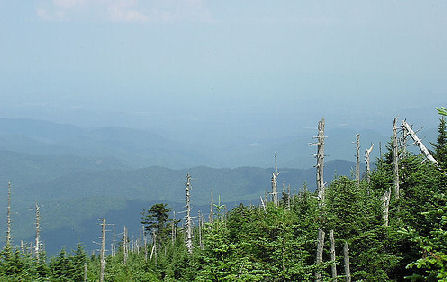 Trees Damaged by Acid Rain
Trees Damaged by Acid Rain © Lindley Ashline
Physical effects on trees & plants through exposure to specific air pollutants are: (Ref. 32)
- Ozone produces a speckle of brown spots, which appear on the flat areas of leaf between the veins.
- Sulfur dioxide: larger bleached-looking areas.
- Nitrogen dioxide: irregular brown or white collapsed lesions on intercostal tissue and near the leaf edge.
- Ammonia: unnatural green appearance with tissue drying out.
Sulfur dioxide has been historically known to produce destructive effects on vegetation and forests. Here is how sulfur dioxide may affect trees & plants: (Ref. 33)
- Cell metabolism disruption (membrane damage, respiration and photosynthetic effects)
- Leaf injury and loss
- Reduced growth and reproduction
- Increase in susceptibility of plants to attacks by insect herbivores
Nitrogen dioxide may also act in synergy with sulfur dioxide to produce a negative effect on plants’ photosynthesis. (Ref. 34)
Tropospheric ozone can have a negative impact on plants’ photosynthesis rates which will stunt their growth; it can also decay plant cells directly by entering stomata. (Ref. 35)
Particulate air pollution effects on plants & trees may include: (Ref. 36)
- Blocked stomata
- Increased leaf temperature
- Reduced photosynthesis
- Reduced fruit set, leaf growth, pollen growth
- Reduced tree growth
- Leaf necrosis and chlorosis, bark peeling
Acid rain (as a product of sulfur and nitrogen pollution) can kill trees, destroy the leaves of plants, can infiltrate soil by making it unsuitable for purposes of nutrition and habitation. (Ref. 37) It is also associated with the reduction in forest and agricultural yields.
(Ref. 38)
Air Pollution Effects – Economic Losses
In addition to health-related problems, atmospheric pollution brings with it economic losses as well.
Some of these economic effects are: (Ref. 39)
- Direct medical losses
- Lost income from being absent from work
- Decreased productivity
- Travel time losses due to reduced visibility
- Losses from repair of damage to buildings
- Increased costs of cleaning
- Losses due to damage to crops & plants
We discuss air pollution effects in more detail here.
Global Warming and Air Pollution
 Hot Earth
Hot Earth© Thiago Kunz
Global warming is a major international problem caused mostly by human actions.
In a way, global warming is part of air pollution.
Global warming is a result of greenhouse gas emissions such as carbon dioxide, methane and nitrous oxide.
Greenhouse gases are air pollutants as well, just like other gases that we’ve discussed in this article.
Because global warming has become a huge issue in its own right, greenhouse gases as air pollutants are usually discussed separately from air pollution.
It is interesting to note that some air pollutants are actually precursors to greenhouse gases.
For example, carbon monoxide (CO) is a precursor to the most powerful greenhouse gas carbon dioxide (CO2).
Both global warming and air pollution are very serious issues that can only be tackled collectively by all the nations working together for one common purpose.
Written by: Irina Bright
Original publication date: 2008
Republication date: 2020
References
1. Ehrlich, P. R., Ehrlich, A. H., & Holdren, J. P. (1977). Ecoscience: Population, Resources, Environment. San Francisco: W. H. Freeman, p. 536. Retrieved November 22, 2008 from Questia.com
2. Arctic haze. (January 7, 2008). In Wikipedia, The Free Encyclopedia. Retrieved April 4, 2008 from http://en.wikipedia.org/w/index.php?title=Arctic_haze&oldid=182689572
3. Best, G. (1999). Environmental Pollution Studies. Liverpool, England: Liverpool University Press, p. 91. Retrieved November 22, 2008 from Questia.com
4. Colls, J. (2002). Air Pollution. New York: Spon Press, p. 25. Retrieved April 3, 2008 from Questia.com
5. Farmer, A. (1997). Managing Environmental Pollution. London: Routledge, p. 26. Retrieved April 3, 2008 from Questia.com
6. Based on articles from:
Environmental Works. (2008). In Encyclopedia Britannica. Retrieved April 4, 2008 from http://library.eb.co.uk/eb/article-214274
7. Santos, M. A. (1990). Managing Planet Earth: Perspectives on Population, Ecology, and the Law. Westport, CT: Bergin & Garvey, p. 51. Retrieved April 3, 2008 from Questia.com
8. Ehrlich, P. R., Ehrlich, A. H., & Holdren, J. P. (1977). Ecoscience: Population, Resources, Environment. San Francisco: W. H. Freeman, pp. 546 – 7. Retrieved November 22, 2008 from Questia.com
9. Colls, J. (2002). Air Pollution. New York: Spon Press, p. 408. Retrieved April 3, 2008 from Questia.com
10. Environmental Works. (2008). In Encyclopedia Britannica. Retrieved April 4, 2008 from http://library.eb.co.uk/eb/article-214274
11. Moore, C. A. (September/October, 1995). Poisons in the Air. International Wildlife, Vol. 25. Retrieved November 22, 2008 from Questia.com
12. Carbon monoxide. (March 6, 2008). In Wikipedia, The Free Encyclopedia. Retrieved April 3, 2008 from http://en.wikipedia.org/w/index.php?title=Carbon_monoxide&oldid=196188223
13. Ehrlich, P. R., Ehrlich, A. H., & Holdren, J. P. (1977). Ecoscience: Population, Resources, Environment. San Francisco: W. H. Freeman, p. 546. Retrieved November 22, 2008 from Questia.com
14. Paulson, G. L., & Nadler, A. C. (1972). Air Pollution. In Ecology and Economics: Controlling Pollution in the 70s, Goldman, M. I. (Ed.) (pp. 73-101). Englewood Cliffs, NJ: Prentice-Hall, p. 85. Retrieved November 22, 2008 from Questia.com
15. Carbon monoxide. (March 6, 2008). In Wikipedia, The Free Encyclopedia. Retrieved April 3, 2008 from http://en.wikipedia.org/w/index.php?title=Carbon_monoxide&oldid=196188223
16. Ozone. (March 11, 2008). In Wikipedia, The Free Encyclopedia. Retrieved April 4, 2008 from http://en.wikipedia.org/w/index.php?title=Ozone&oldid=197484961
17. Tropospheric ozone. (March 5, 2008). In Wikipedia, The Free Encyclopedia. Retrieved April 4, 2008 from http://en.wikipedia.org/w/index.php?title=Tropospheric_ozone&oldid=196160653
18. Moore, C. A. (September/October, 1995). Poisons in the Air. International Wildlife, Vol. 25. Retrieved November 22, 2008 from Questia.com
19. O’Fallon, D. & Sieff, P. (February 2002). Minot, North Dakota, Train Derailment. Published by Robins, Kaplan, Miller & Ciresi LLP. Retrieved November 22, 2008 from http://www.rkmc.com/Minot_North_Dakota_Train_Derailment.htm
20. Canadian Centre for Occupational Health and Safety (October 22, 2008). Ammonia Gas: Health Effects of Ammonia Gas. Retrieved November 22, 2008 from http://www.ccohs.ca/oshanswers/chemicals/chem_profiles/ammonia/health_ammonia.html
21. Delaware Health & Social Services, State of Delaware (May, 2007). Public Information: Ammonia (NH3). Retrieved November 22, 2008 from http://www.dhss.delaware.gov/dph/files/ammoniapi.pdf
22. Colls, J. (2002). Air Pollution. New York: Spon Press, pp. 409 – 10. Retrieved April 3, 2008 from Questia.com
23. Haughton, G., & Hunter, C. (2003). Sustainable Cities. London: Routledge, p. 153. Retrieved November 22, 2008 from Questia.com
24. Occupational Disease. (2008). In Encyclopedia Britannica. Retrieved November 17, 2008 from Encyclopedia Britannica Online Library Edition: http://library.eb.co.uk/eb/article-14278
25. Benzene. (November 16, 2008). In Wikipedia, The Free Encyclopedia. Retrieved November 22, 2008 from http://en.wikipedia.org/w/index.php?title=Benzene&oldid=252113046
26. 1,3-Butadiene. (November 3, 2008). In Wikipedia, The Free Encyclopedia. Retrieved November 22, 2008 from http://en.wikipedia.org/w/index.php?title=1,3-Butadiene&oldid=249411792
27. Moore, C. A. (September/October, 1995). Poisons in the Air. International Wildlife, Vol. 25. Retrieved November 22, 2008 from Questia.com
28. Glinianaia, S. V., Rankin, J., Bell, R., Pless-Mulloli, T., & Howel, D. (2004). Does Particulate Air Pollution Contribute to Infant Death? A Systematic Review. Environmental Health Perspectives, Vol. 112. Retrieved November 22, 2008 from Questia.com
29. Bell, M. L., Ebisu, K., & Belanger, K. (2007). Ambient Air Pollution and Low Birth Weight in Connecticut and Massachusetts. Environmental Health Perspectives, Vol. 115. Retrieved November 22, 2008 from Questia.com
30. Phelps, J. (2004). Air Pollution Impairs Lung Development in Children. Environmental Health Perspectives, Vol. 112. Retrieved November 22, 2008 from Questia.com
31. U.S. Environmental Protection Agency (May 9, 2008). Particulate Matter: Health and Environment. Retrieved November 22, 2008 from http://www.epa.gov/oar/particlepollution/health.html
32. Colls, J. (2002). Air Pollution. New York: Spon Press, p. 354. Retrieved April 3, 2008 from Questia.com
33. Farmer, A. (1997). Managing Environmental Pollution. London: Routledge, p. 51. Retrieved April 3, 2008 from Questia.com
34. Ibid., p. 47
35. Gardiner, L. (February, 2006). Air Pollution Affects Plants, Animals, and Environments. Published by Windows to the Universe. Retrieved April 3, 2008 from http://www.windows.ucar.edu/tour/link=/earth/Atmosphere/wildlife_forests.html&edu=high
36. Farmer, A. (1997). Managing Environmental Pollution. London: Routledge, p. 49. Retrieved April 3, 2008 from Questia.com
37. Gardiner, L. (February, 2006). Air Pollution Affects Plants, Animals, and Environments. Published by Windows to the Universe. Retrieved April 3, 2008 from http://www.windows.ucar.edu/tour/link=/earth/Atmosphere/wildlife_forests.html&edu=high
38. Santos, M. A. (1990). Managing Planet Earth: Perspectives on Population, Ecology, and the Law. Westport, CT: Bergin & Garvey, p. 51. Retrieved April 3, 2008 from Questia.com
39. Gilpin, A. (1999). Environmental Economics: A Critical Overview. Chichester, England: John Wiley & Sons, p. 201. Retrieved November 22, 2008 from Questia.com